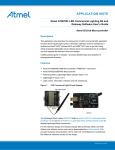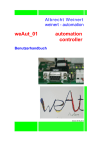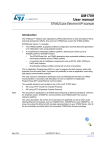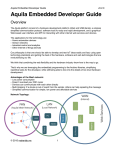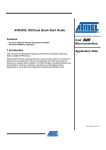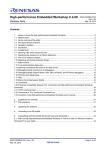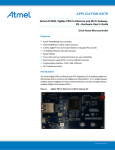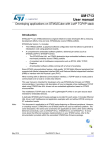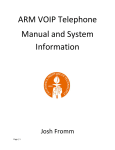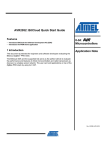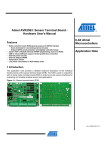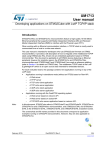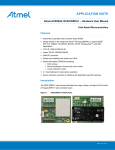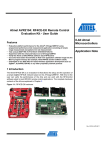Download Lightweight Mesh to Ethernet Gateway with
Transcript
APPLICATION NOTE
Atmel AT02744: Lightweight Mesh to Ethernet Gateway
with SAM3X - Software User’s Guide
Atmel 32-bit Microcontroller
Features
•
•
•
•
Atmel® ATSAM3X8E microcontroller
Atmel AT86RF231 2.4GHz radio transceiver
Atmel proprietary Lightweight Mesh software stack
10/100Mbps Ethernet
•
•
•
•
LwIP TCP/IP stack support
TCP/IP client
Single MCU gateway solution
Preprogrammed firmware of wireless lighting control via PC software
Introduction
This application note mainly describes the software architecture and the application
programming interfaces (API) of Lightweight Mesh to Ethernet Gateway reference
design (hereafter the Gateway).
A getting started guide at the end of this document gives details about the setup and
operation of preprogrammed firmware.
Figure 1.
Lightweight Mesh to Ethernet Gateway.
The Gateway is based on Atmel ATSAM3X8E microcontroller and Atmel AT86RF231
2.4GHz radio transceiver. For gateway hardware design details, refer to Atmel
AT2200: ZigBee® to Ethernet and Wi-Fi Gateway with SAM3X - Hardware User's
Guide.
42165A−SAM−11/2013
For this reference design, the hardware design files (schematic, BOM and PCB
Gerber) and software source code can be downloaded from Atmel website. The
provided hardware documentation can be used with no limitations to manufacture the
reference hardware solution for the design.
Atmel AT02744: Lightweight Mesh to Ethernet Gateway with SAM3X - Software User’s Guide
[APPLICATION NOTE]
42165A−SAM−11/2013
2
Table of Contents
1. Overview .............................................................................................. 4 2. Development Tools .............................................................................. 4 3. Software Architecture ........................................................................... 4 3.1 Atmel Lightweight Mesh Software Stack ........................................................... 5 3.2 LwIP TCP/IP Stack............................................................................................ 6 3.3 PC software ...................................................................................................... 6 4. Inside the Gateway Application ............................................................ 8 4.1 Gateway Application Layer Structure ................................................................ 8 4.2 Lightweight Mesh Task ..................................................................................... 8 4.3 LwIP Task ....................................................................................................... 10 5. Main API Introduction ......................................................................... 11 5.1 Lightweight Mesh Software Stack API ............................................................ 11 5.2 LwIP API Introduction...................................................................................... 12 6. Software Package Content ................................................................ 13 7. Footprint ............................................................................................. 16 8. Getting Started Guide ........................................................................ 17 8.1 Programming the Gateway ............................................................................. 17 8.2 Connecting to Ethernet ................................................................................... 18 8.2.1 Step-by-step guide ............................................................................ 18 8.3 PC software Menu........................................................................................... 20 Appendix A. Additional Information .................................................... 21 A.1 Lightweight Mesh Configuration ...................................................................... 21 A.2 LwIP Configuration .......................................................................................... 21 Appendix B. Revision History ............................................................ 22 Atmel AT02744: Lightweight Mesh to Ethernet Gateway with SAM3X - Software User’s Guide
[APPLICATION NOTE]
42165A−SAM−11/2013
3
1.
Overview
The Lightweight Mesh to Ethernet Gateway is designed to interface Lightweight Mesh network to Ethernet network.
Through the Gateway, the user can control and monitor any nodes in Lightweight Mesh network remotely via Ethernet.
A typical application scenario is shown in Figure 1-1.
Figure 1-1. Typical Gateway Application Scenario.
In the preprogrammed firmware, a wireless lighting control and monitor network is established. The lights in Lightweight
Mesh network can be controlled and monitored via PC software remotely.
2.
Development Tools
To download or debug the preprogrammed firmware, the following development toolchain is needed:
•
•
•
•
•
3.
Atmel Studio 6. Version: 6.1.2674 with Service Pack 1 or above
Atmel ARM® GNU Toolchain. Version: 4.7.3.158 - GCC 4.7.3 or above
Atmel Software Framework. Version: 3.9.1 or above
Programming and debugging device: Atmel SAM-ICE™
SAM-ICE Adaptor: a minimized (1.27mm pitch 10-pin header) adaptor for Atmel SAM-ICE. For more details
refer to Atmel AVR2033: SAM-ICE Adapter - Hardware User Manual
Software Architecture
The software for the Gateway is composed of two main parts:
• Atmel Lightweight Mesh Software Stack
• LwIP TCP/IP Stack
Besides the Gateway itself, PC software named “TCP server” is also provided as a simple graphic user interface (GUI).
Atmel AT02744: Lightweight Mesh to Ethernet Gateway with SAM3X - Software User’s Guide
[APPLICATION NOTE]
42165A−SAM−11/2013
4
The Gateway application is designed based on Atmel Software Framework (ASF). In fact, except the Lightweight Mesh
Software Stack, other modules are from ASF.
The Gateway exchanges data between Lightweight Mesh network and Ethernet network. The Lightweight Mesh
network data is collected by the Gateway and transferred into Ethernet network, and finally displayed in PC software.
The user input in PC software is also sent back to Lightweight Mesh network via the Gateway.
The software block diagram of the Gateway is given in Figure 3-1.
Figure 3-1. The Gateway Software Block Diagram.
3.1
Atmel Lightweight Mesh Software Stack
Atmel Lightweight Mesh is the easy-to-use proprietary low power wireless mesh network protocol from Atmel. It is
designed to work with all Atmel IEEE® 802.15.4 transceivers and SoCs. To find more detailed information about the
Lightweight Mesh architecture and application development process, refer to Atmel AVR2130: Lightweight Mesh
Developer Guide.
Atmel Lightweight Mesh software stack features:
•
•
•
•
•
•
•
Simplicity of configuration and use
Up to 65535 nodes in one network (theoretical limit)
Up to 65535 separate PANs on one channel
Up to 15 independent application endpoints
No dedicated node is required to start a network
No periodic service traffic occupying bandwidth
Two distinct types of nodes:
• Routing (network address < 0x8000)
• Non-routing (network address >= 0x8000)
• Once powered on, the node is ready to send and receive data; no special joining procedure is required
• No child-parent relationship between the nodes
• Non-routing nodes can send and receive data to/from any other node (including non-routing nodes), but they
will never be used for routing purposes
•
•
•
•
Route discovery happens automatically if route to the destination is not known
Routing table is updated automatically based on the data from the received and transmitted frames
Duplicate frames (broadcast or multipath unicast) are rejected
Small footprint (less than 8kB of Flash and 4kB of RAM for a typical application)
Atmel AT02744: Lightweight Mesh to Ethernet Gateway with SAM3X - Software User’s Guide
[APPLICATION NOTE]
42165A−SAM−11/2013
5
Currently the public release version of Lightweight Mesh software stack works with AVR®-based MCUs, but given its
extreme portability and low resource requirements, it can be run on almost any Atmel MCU.
In the Gateway, it runs on ATSAM3X8E MCU. The Lightweight Mesh software stack version is v1.0.0.
Note that at time of writing this application note, the Atmel Lightweight Mesh Software Stack is not integrated into ASF.
In this reference design, the files in hal folder of Lightweight Mesh Software Stack are modified to reuse the low level
drivers from ASF.
3.2
LwIP TCP/IP Stack
The Lightweight TCP/IP stack is designed for embedded systems. The focus of the LwIP TCP/IP implementation is to
reduce resource usage while still having a full scale TCP.
LwIP features:
•
•
•
•
•
•
•
•
•
IP (Internet Protocol) including packet forwarding over multiple network interfaces
ICMP (Internet Control Message Protocol) for network maintenance and debugging
UDP (User Datagram Protocol) including experimental UDP-lite extensions
TCP (Transmission Control Protocol) with congestion control, RTT estimation and fast recovery/fast retransmit
Specialized raw API for enhanced performance
Optional Berkeley-alike socket API
DHCP (Dynamic Host Configuration Protocol)
PPP (Point-to-Point Protocol)
ARP (Address Resolution Protocol) for Ethernet
For more detailed information about the LwIP, refer to LwIP Wiki: http://lwip.wikia.com/wiki/LwIP_Wiki or the Atmel
AVR32817: Getting Started with the 32-bit AVR® UC3 Software Framework LwIP TCP/IP Stack application note.
In the Gateway, only TCP/IP client is implemented. The LwIP version is 1.4.0.
3.3
PC software
PC software named “TCPServer” is provided to control and monitor devices in Lightweight Mesh network.
The following information is displayed in the “TCPServer” main window.
•
•
•
•
•
•
•
•
•
Device: End device or Router
Address: Device short address in Lightweight Mesh network
Status: Device in network or not
Channel: Working channel
PAN ID: Lightweight Mesh network PAN ID
LQI: Link quality Indicator of the last data transfer
RSSI: Received Signal Strength Indication of the last data transfer
TSensor: Dummy sensor data sent from devices in Lightweight Mesh network
LED status: LED on / off status
When clicking on a specific device in main window, the selected device can be controlled and monitored in the
“TCPServer” control window.
• The LED status will be displayed. Red stands for “ON”, and blank indicates “OFF”
• The LED can be turned on or off by selecting “ON” or “OFF” and clicking “Submit”
Atmel AT02744: Lightweight Mesh to Ethernet Gateway with SAM3X - Software User’s Guide
[APPLICATION NOTE]
42165A−SAM−11/2013
6
The following information is displayed in the status bar:
•
•
•
•
•
The server status
Client IP address
Port number
Number of devices in Lightweight Mesh network
Received data pack
A screenshot of the PC software is shown in Figure 3-2. For details of the PC software operation, check Chapter 8.
Figure 3-2. The Gateway PC Software “TCPServer”.
Main Window
Control Window
Status Bar
Atmel AT02744: Lightweight Mesh to Ethernet Gateway with SAM3X - Software User’s Guide
[APPLICATION NOTE]
42165A−SAM−11/2013
7
4.
Inside the Gateway Application
In this chapter, the overall Gateway application layer structure is explained. And by different functions, the main
application tasks in the Gateway are introduced in two parts: Lightweight Mesh, LwIP task.
4.1
Gateway Application Layer Structure
As the Gateway is based on WSNDemo example from Lightweight Mesh Software Stack, it has similar structure in
main(). The main() function of the Gateway is shown below:
int main(void)
{
sysclk_init();
board_init();
…
init_ethernet();
…
/* This is the main polling loop */
while (1) {
/* LwMesh task handler */
SYS_TaskHandler();
HAL_UartTaskHandler();
…
APP_TaskHandler();
...
ethernet_task();
…
}
}
sysclk_init() and board_init() are two functions to initialize clock and board from ASF. The Lightweight Mesh
Software Stack hardware initializations are also put in board_init(). init_ethernet() is to initialize Ethernet.
The task handlers in the while loop handles application tasks. They are introduced in the following sections. By following
this structure, more functions can be added into main() to enrich the Gateway features.
Several macro switches are defined in conf_board.h to give different application options. Here are some examples.
• #define LWMESH_USED
1 // Enable LWMESH PHY
• #define ETH_USED
1 // Enable Ethernet
…
To run the Gateway with default features, don’t not change the macro switches unless you know what it changes clearly.
4.2
Lightweight Mesh Task
In the Gateway, Lightweight Mesh task is based on WSNDemo example from Lightweight Mesh Software Stack.
The SYS_TaskHandler() and APP_TaskHandler() are the two APIs of Lightweight Mesh task. They should be
called as frequently as possible. The Lightweight Mesh stack low layer tasks are handled by calling
SYS_TaskHandler(). The application layer is handled in APP_TaskHandler().
The Gateway is a node in Ethernet network. It sends data to Ethernet by calling appSendData() from
APP_TaskHandler() at a predefined interval.
The Gateway acts as Coordinator in Lightweight Mesh network. It receives data from other Lightweight Mesh devices
from callback function appDataInd() and sends data back to Lightweight Mesh network by filling the
Acknowledgment command frame in this function.
Atmel AT02744: Lightweight Mesh to Ethernet Gateway with SAM3X - Software User’s Guide
[APPLICATION NOTE]
42165A−SAM−11/2013
8
Figure 4-1. Lightweight Mesh Task Flow.
APP_STATE_INITIAL
appInit();
APP_STATE_SEND
appSendData();
APP_STATE_SENDING_DONE
appDataSendingTimerHandler();
SYS_TimerStart( );
Data received
APP_STATE_SEND
appDataInd();
APP_STATE_WAIT_SEND_TIMER
ACK Control field
filled
Atmel AT02744: Lightweight Mesh to Ethernet Gateway with SAM3X - Software User’s Guide
[APPLICATION NOTE]
42165A−SAM−11/2013
9
4.3
LwIP Task
The Gateway is configured as TCP client when LwIP network connection is initialized.
The LwIP task uses the ethernet_task() function to read data packet and run periodical tasks. This function should
be called periodically. If Ethernet is used, the Gateway tries to connect to TCP server on a port specified in firmware.
After successful connection, the Gateway is informed of incoming data through callback function
tcp_client_received(). The data is sent to LwIP by calling appSendMessageToLwIP().
Figure 4-2. LwIP Task Flow.
lwip_init
ethernet_configure_interface
ethernet_task
Data received?
No
Yes
No
IP packet?
Yes
No
ARP packet?
ip_input
Yes
etharp_arp_input
TCP protocol?
No
Yes
tcp_input
Other protocol handler
tcp_client_received
appSendMessageToLwIP
tcp_write
tcp_output
Atmel AT02744: Lightweight Mesh to Ethernet Gateway with SAM3X - Software User’s Guide
[APPLICATION NOTE]
42165A−SAM−11/2013
10
5.
Main API Introduction
The main API’s introduction will be divided into two parts: Lightweight Mesh Software Stack API, LwIP Stack API driver
API. Each part will be introduced respectively in the following sections. Note the APIs described here are focusing on
application layer. For complete API descriptions, refer to the stacks and their documents mentioned in Chapter 3.
5.1
Lightweight Mesh Software Stack API
As the Lightweight Mesh task is based on WSNDemo example, similar APIs in WSNDemo are used in the Gateway.
Most of the Lightweight Mesh APIs used in Gateway are in WSNDemo.c.
The main APIs are as below.
• SYS_Init()
It initializes Lightweight Mesh HAL, PHY, NWK layer and system timer. It’s called from board_init().
• SYS_TaskHandler()
It’s the core API of Lightweight Mesh. The PHY, NWK and system timer task handlers are called in this API.
• APP_TaskHandler()
It’s the application layer task handler of Lightweight Mesh.
The main purpose of using Lightweight Mesh on Gateway is to exchange data. Here are some APIs for sending and
receiving data.
• appDataInd()
The call back function registered by NWK_OpenEndpoint() in appInit(). It’s called when valid data
received from Lightweight Mesh low level layer.
It also fills the Acknowledgment command frame control field by calling NWK_SetAckControl(). Thus
the data sent back to Lightweight Mesh network is implemented in a very simple manner. The limit here is
the control field is only one byte. If large amount of data needs to be transmitted, a dedicated API and
structure should be used. Refer to the none-coordinator code in WSNDemo.c for example.
• appSendData()
It’s called by a predefined interval from APP_TaskHandler(). appSendMessageToLwIP()and
appSendMessage()are called in this function to send data to LwIP Tx buffer respectively.
The timer API is used to generate fix interval through call back function. Here is the timer call back function in
application layer.
• appDataSendingTimerHandler()
It is registered by SYS_TimerStart() and called at predefined interval.
As the Gateway acts as Coordinator in Lightweight Mesh network, some APIs from the stack are not used. For more
details about other APIs in Lightweight Mesh, refer to the software package and documents inside. The latest
Lightweight Mesh Software Stack package can be downloaded
from http://www.atmel.com/tools/LIGHTWEIGHT_MESH.aspx.
Atmel AT02744: Lightweight Mesh to Ethernet Gateway with SAM3X - Software User’s Guide
[APPLICATION NOTE]
42165A−SAM−11/2013
11
5.2
LwIP API Introduction
As no operating system is running, LwIP raw API has been used in the Gateway. And the Gateway is set as TCP client.
Most of the LwIP APIs are in ethernet_sam.c.
The main APIs of LwIP are as below:
• init_ethernet()
It initializes LwIP Ethernet interface and related hardware.
• ethernet_task()
The LwIP Ethernet task handler. It polls the Ethernet tasks periodically. The specific application codes are
implemented in several call back functions.
• tcp_client_init()
It initializes the Gateway as TCP client. By default, static IP is assigned to Gateway and a port number is
bound. In this function, it tries to connect to TCP server with the default parameters.
• appSendMessageToLwIP()
This function sends data from Lightweight Mesh to LwIP. It fills the data buffer to be transferred.
tcp_write() and tcp_ouput() are the actual functions sends data in LwIP.
Here is the list of callback functions used in the Gateway.
• tcp_client_received()
It’s the callback function invoked whenever a data packet is received from LwIP. For Gateway, it stores
data received from TCP server in a buffer.
• tcp_client_connected()
It’s the callback function invoked when a TCP connection is established. It sends a string to TCP server
after successful connection and set TCP client in receive state by registering a callback function
tcp_client_received() in tcp_recv().
• tcp_err_handler()
It’s the callback function for TCP error handler. It re-initializes Gateway to TCP client if connection aborted
or connection reset occurs in LwIP.
• status_callback()
It’s the callback function for a status change in default network interface. It initializes the Gateway as
TCP client by calling tcp_client_init().
For more details about LwIP APIs, refer to LwIP stack.
Atmel AT02744: Lightweight Mesh to Ethernet Gateway with SAM3X - Software User’s Guide
[APPLICATION NOTE]
42165A−SAM−11/2013
12
6.
Software Package Content
As mentioned before, the Gateway is developed based on ASF. The directory structure of the software package
integrates ASF structure and Lightweight Mesh Software Stack structure. For details of the structure of ASF, refer
to Atmel AVR4029: Atmel Software Framework - Getting Started. For the structure of Lightweight Mesh, refer to Atmel
AVR2130: Lightweight Mesh Developer Guide.
The Gateway directory structure is shown as below:
Figure 6-1. The Gateway Directory Structure.
Atmel AT02744: Lightweight Mesh to Ethernet Gateway with SAM3X - Software User’s Guide
[APPLICATION NOTE]
42165A−SAM−11/2013
13
The directory details are described below:
• apps:
•
WSNDemo
The Gateway application layer code. The main() is in WSNDemo.c.
• asf:
•
common
y boards
y
This directory contains the various board definitions shared between multiple architectures. As the
Gateway is not a standard Atmel Kit, it’s defined as USER_BOARD. And the board details are
defined user_board.h and conf_board.h.
services
y
utils
ASF common services.
ASF common utilities.
•
sam
y
components
y
Components supported by sam. Here the Gateway Ethernet PHY chip is supported by ASF.
drivers
ASF sam drivers. It contains the low level drivers of sam peripherals.
y
utils
ASF sam utilities.
•
thirdparty
y CMSIS
ARM Cortex® Microcontroller Software Interface Standard folder.
y
lwip
LwIP stack folder.
• config:
•
conf_board.h
The ASF config file of board. The Gateway board settings and macros are placed in this file.
•
conf_clock.h
The ASF config file of clock. The Gateway clock settings can be configured here.
•
conf_eth.h
The ASF config file of EMAC. The Gateway Ethernet hardware, MAC address and IP address (if static
IP if used) etc. are defined in this file.
•
conf_spi_master.h
The ASF config file of SPI in master mode.
•
conf_uart_serial.h
The ASF config file of UART port. It’s for debug purpose in the Gateway.
•
config.h
The config file of Lightweight Mesh Software Stack. The device type and working channel are defined in
this file.
•
lwipopts.h
The config file of LwIP stack.
Atmel AT02744: Lightweight Mesh to Ethernet Gateway with SAM3X - Software User’s Guide
[APPLICATION NOTE]
42165A−SAM−11/2013
14
• stack:
•
hal
y
atsam3x8e
Hardware abstraction layer of Lightweight Mesh Software Stack. In the Gateway, it reuses the low
level drivers from ASF.
•
nwk
Network layer of Lightweight Mesh Software Stack.
•
phy
y
at86rf231
The radio PHY chip supported by the Gateway.
•
Services
The Lightweight Mesh application services. OTA service is provided, but it’s not used in the Gateway. It
can be removed from the project folder with no harm. It’s kept there for not breaking Lightweight Mesh
Software Stack original structure.
•
Sys
The Lightweight Mesh system services.
Atmel AT02744: Lightweight Mesh to Ethernet Gateway with SAM3X - Software User’s Guide
[APPLICATION NOTE]
42165A−SAM−11/2013
15
7.
Footprint
Figure 7-1 and Figure 7-2 illustrate the CODE and RAM spaces that each module used in the software of the Gateway.
Figure 7-1. Lightweight Mesh to Ethernet Gateway CODE Footprint [KB].
Toochain lib; 5.312 ASF; 5.142 LwIP; 19.358 LwMesh; 5.848 Application; 1.504 Figure 7-2. Lightweight Mesh to Ethernet Gateway RAM Footprint [KB].
LwIP; 8.156 emac buffer; 14.192 Application; 0.312 LwMesh; 3.012 stack size; 8.196 ASF; 0.392 Toolchain lib; 2.196 The Lightweight Mesh and LwIP stack RAM usage should be configured in their corresponding configuration file
according to real application.
Atmel AT02744: Lightweight Mesh to Ethernet Gateway with SAM3X - Software User’s Guide
[APPLICATION NOTE]
42165A−SAM−11/2013
16
8.
Getting Started Guide
In this chapter, it gives step-by-step guide to setup the Gateway and run the preprogrammed firmware.
8.1
Programming the Gateway
Along with this document, two hex files are provided. One is for the Gateway (LwMesh_Gateway.hex) and the other is
for Lightweight Mesh devices connecting to the Gateway (LwMesh_RCB128RFA1.hex).
To program the Gateway hex file, SAM-ICE adaptor mentioned in Chapter 2 is needed. The steps are as below.
1.
2.
3.
4.
5.
6.
7.
8.
Connect SAM-ICE to the SAM-ICE adapter.
Connect SAM-ICE adapter to the Gateway programming header J2.
Power the Gateway via the USB cable.
Open Atmel Studio and select menu “Tools -> Device Programming”.
Choose SAM-ICE for Tool, ATSAM3X8E for Device and JTAG for Interface, and then click “Apply” button.
Click the Device signature “Read” button to check if the connection is correct.
Select the Memories tab and then select the pre-built image for the Gateway from “…” in Flash section.
Click Program. If the pre-built image is downloaded to the board, message “Verifying Flash…OK” appears.
Figure 8-2. Programming the Gateway.
The hex file for Lightweight Mesh devices is running on RCB128RFA1. It acts as End Device in the network. LED (D4)
on RCB128RFA1 can be monitored and controlled through the Gateway. Refer to Atmel AVR2131: Lightweight Mesh
Getting Started Guide for the setup and programming the RCB128RFA1 Radio Control Board.
Atmel AT02744: Lightweight Mesh to Ethernet Gateway with SAM3X - Software User’s Guide
[APPLICATION NOTE]
42165A−SAM−11/2013
17
8.2
Connecting to Ethernet
In the preprogrammed firmware, the Gateway Ethernet is configured as below.
• TCP client
• Server IP: 192.168.1.105. Port: 8840
• Gateway static IP: 192.168.1.101. Sub net mask: 255.255.255.0. Default Gateway: 192.168.1.1
The parameters can be changed in the Gateway firmware, but the PC software “TCPServer” provided with this
document is designed to work with the settings above.
8.2.1
Step-by-step guide
To directly connect the Gateway to PC via Ethernet, follow the steps below.
1.
Configure PC IP address to 192.168.1.105, Sub net mask: 255.255.255.0, Default Gateway: 192.168.1.1 as
shown in Figure 8-1.
Figure 8-1. PC IP address configuration.
2.
3.
4.
Connect Ethernet cable between Gateway and PC.
Power on Gateway by connecting USB cable. Ethernet connection status is indicated by LED D2, D3 and D4
on Gateway. The red color of bi-color LED D7 on Gateway will be on when Lightweight Mesh network ready.
Open “TCPServer” in PC. If the Gateway and PC are setup correctly, “TCPServer” will report “Connected”,
“Client IP” and “Port” in the status bar as shown in Figure 8-2.
Atmel AT02744: Lightweight Mesh to Ethernet Gateway with SAM3X - Software User’s Guide
[APPLICATION NOTE]
42165A−SAM−11/2013
18
Figure 8-2. The Gateway connected to “TCPServer”.
5.
Power on the other Lightweight Mesh devices. If the Lightweight Mesh devices are setup correctly, the device
information will be displayed in the main window of “TCPServer” as shown in Figure 8-3. The green color of bicolor LED D7 on Gateway will toggle each time it receives data from connected devices.
Figure 8-3. Lightweight Mesh devices connected via Ethernet.
6.
Click on one device in main window. The LED status on selected device is displayed in control window. Select
“ON” or “OFF” and then click “Submit”, the LED on the device can be controlled accordingly.
Atmel AT02744: Lightweight Mesh to Ethernet Gateway with SAM3X - Software User’s Guide
[APPLICATION NOTE]
42165A−SAM−11/2013
19
8.3
PC software Menu
The TCPServer provided with this document is a simple GUI to demonstrate the Gateway reference design. In a real
application, a more complicated GUI may be used.
For an overview of the PC software features refer to Section 3.3. The menu of TCPServer is simple. Only the menu
items under “Action” are implemented. They are described as below.
• Refresh List: Refresh the device list manually
• Start Listening: Start listening on the default server port 8840
• Stop Listening: Stop listening on the default server port 8840
Whenever the device list is not updated or showing “Not Found” in main window as in Figure 8-4, the TCPServer can
restart working by selecting “Stop Listening” and “Start Listening”.
Figure 8-4. Device Not Found in TCPSerever.
Atmel AT02744: Lightweight Mesh to Ethernet Gateway with SAM3X - Software User’s Guide
[APPLICATION NOTE]
42165A−SAM−11/2013
20
Appendix A.
A.1
Additional Information
Lightweight Mesh Configuration
Table A-1 lists the Lightweight Mesh Software Stack configuration used in this reference design and this configuration
can be modified in src/config/config.h.
Table A-1.
A.2
Lightweight Mesh Options.
Option
Value
Description
APP_ADDR
0 - Coordinator
Node network address. It should be 0 for the Gateway
APP_CHANNEL
0x18
APP_PAN_ID
0x1234
Radio transceiver channel. Valid range for 2.4GHz radios is 11 – 26
(0x0b – 0x1a)
Network identifier
APP_ENDPOINT
1
Application main data communication endpoint
NWK_BUFFERS_AMOUNT
10
Number of buffers reserved for stack operation
HAL_UART_RX_FIFO_SIZE
4
UART RX buffer size
LwIP Configuration
Table A-2 lists the LwIP stack configuration in this reference design, and these configurations can be modified in
src/config/lwipopts.h.
Table A-2.
LwIP Options.
Option
Value
Description
MEM_SIZE
3*1024
The size of the heap memory
MEMP_NUM_PBUF
12
The number of memp struct pbufs
MEMP_NUM_TCP_PCB
2
The number of simultaneously active TCP
connections
MEMP_NUM_TCP_PCB_LISTEN
1
The number of listening TCP connections
MEMP_NUM_TCP_SEG
9
The number of simultaneously queued TCP
segments
PBUF_POOL_SIZE
6
The number of buffers in the pbuf pool
PBUF_POOL_BUFSIZE
512
The size of each pbuf in the pbuf pool
LWIP_TCP
1
Turn on TCP
TCP_WND
1500
The size of a TCP window
TCP_MSS
1500
TCP Maximum segment size
TCP_SND_BUF
2150
TCP sender buffer space
TCP_SND_QUEUELEN
(6 * (TCP_SND_BUF) +
(TCP_MSS - 1))/(TCP_MSS)
TCP sender buffer space
Atmel AT02744: Lightweight Mesh to Ethernet Gateway with SAM3X - Software User’s Guide
[APPLICATION NOTE]
42165A−SAM−11/2013
21
Appendix B.
Revision History
Doc. Rev.
Date
Comments
42165A
11/2013
Initial document release
Atmel AT02744: Lightweight Mesh to Ethernet Gateway with SAM3X - Software User’s Guide
[APPLICATION NOTE]
42165A−SAM−11/2013
22
Atmel Corporation
Atmel Asia Limited
Atmel Munich GmbH
Atmel Japan G.K.
1600 Technology Drive
Unit 01-5 & 16, 19F
Business Campus
16F Shin-Osaki Kangyo Building
San Jose, CA 95110
BEA Tower, Millennium City 5
Parkring 4
1-6-4 Osaki, Shinagawa-ku
USA
418 Kwun Tong Road
D-85748 Garching b. Munich
Tokyo 141-0032
Tel: (+1)(408) 441-0311
Kwun Tong, Kowloon
GERMANY
JAPAN
Fax: (+1)(408) 487-2600
HONG KONG
Tel: (+49) 89-31970-0
Tel: (+81)(3) 6417-0300
www.atmel.com
Tel: (+852) 2245-6100
Fax: (+49) 89-3194621
Fax: (+81)(3) 6417-0370
Fax: (+852) 2722-1369
© 2013 Atmel Corporation. All rights reserved. / Rev.: 42165A−SAM−11/2013
Atmel®, Atmel logo and combinations thereof, Enabling Unlimited Possibilities®, AVR®, and others are registered trademarks or trademarks of Atmel Corporation
or its subsidiaries. ARM® and Cortex® are registered trademarks or trademarks of ARM Ltd. Other terms and product names may be trademarks of others.
Disclaimer: The information in this document is provided in connection with Atmel products. No license, express or implied, by estoppel or otherwise, to any intellectual property right is granted by this
document or in connection with the sale of Atmel products. EXCEPT AS SET FORTH IN THE ATMEL TERMS AND CONDITIONS OF SALES LOCATED ON THE ATMEL WEBSITE, ATMEL ASSUMES
NO LIABILITY WHATSOEVER AND DISCLAIMS ANY EXPRESS, IMPLIED OR STATUTORY WARRANTY RELATING TO ITS PRODUCTS INCLUDING, BUT NOT LIMITED TO, THE IMPLIED
WARRANTY OF MERCHANTABILITY, FITNESS FOR A PARTICULAR PURPOSE, OR NON-INFRINGEMENT. IN NO EVENT SHALL ATMEL BE LIABLE FOR ANY DIRECT, INDIRECT,
CONSEQUENTIAL, PUNITIVE, SPECIAL OR INCIDENTAL DAMAGES (INCLUDING, WITHOUT LIMITATION, DAMAGES FOR LOSS AND PROFITS, BUSINESS INTERRUPTION, OR LOSS OF
INFORMATION) ARISING OUT OF THE USE OR INABILITY TO USE THIS DOCUMENT, EVEN IF ATMEL HAS BEEN ADVISED OF THE POSSIBILITY OF SUCH DAMAGES. Atmel makes no
representations or warranties with respect to the accuracy or completeness of the contents of this document and reserves the right to make changes to specifications and products descriptions at any time
without notice. Atmel does not make any commitment to update the information contained herein. Unless specifically provided otherwise, Atmel products are not suitable for, and shall not be used in,
automotive applications. Atmel products are not intended, authorized, or warranted for use as components in applications intended to support or sustain life.























